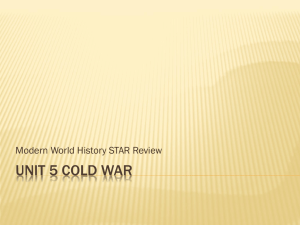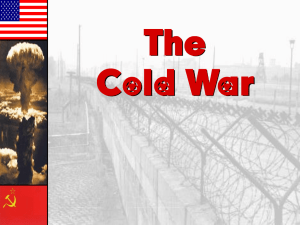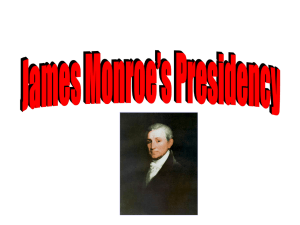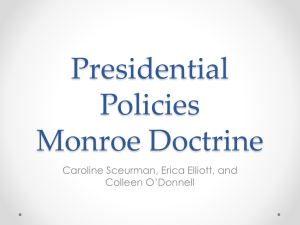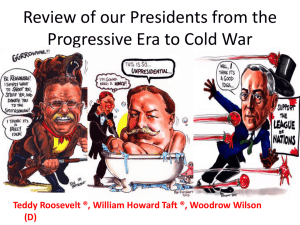Big 50 pt 2 REGENTS Questions
advertisement
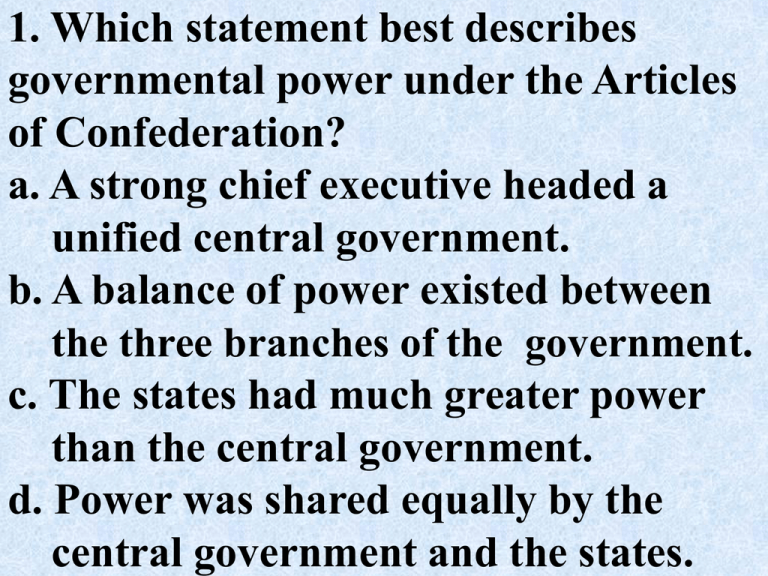
1. Which statement best describes governmental power under the Articles of Confederation? a. A strong chief executive headed a unified central government. b. A balance of power existed between the three branches of the government. c. The states had much greater power than the central government. d. Power was shared equally by the central government and the states. 1. Which statement best describes governmental power under the Articles of Confederation? a. A strong chief executive headed a unified central government. b. A balance of power existed between the three branches of the government. c. The states had much greater power than the central government. d. Power was shared equally by the central government and the states. 2. To address the weaknesses of the Articles of Confederation, delegates at the Constitutional Convention agreed to a. decrease the number of states. b. increase the powers of the central government. c. eliminate the slave trade. d. allow states to set tariff rates. 2. To address the weaknesses of the Articles of Confederation, delegates at the Constitutional Convention agreed to a. decrease the number of states. b. increase the powers of the central government. c. eliminate the slave trade. d. allow states to set tariff rates. 3. The Wagner Act of 1935 gave labor unions the right to a. represent workers in collective bargaining. b. use blacklists and yellow dog contracts. c. establish quotas on immigration. d. insist on an open shop in the workplace. 3. The Wagner Act of 1935 gave labor unions the right to a. represent workers in collective bargaining. b. use blacklists and yellow dog contracts. c. establish quotas on immigration. d. insist on an open shop in the workplace. 4. The Truman Doctrine was originally designed to a. Rebuild Southeast Asia by extending economic aid. b. contain communism by giving aid to Greece and Turkey. c. use the United Nations as a tool to eliminate communism. d. stop the proliferation of nuclear weapons. 4. The Truman Doctrine was originally designed to a. Rebuild Southeast Asia by extending economic aid. b. contain communism by giving aid to Greece and Turkey. c. use the United Nations as a tool to eliminate communism. d. stop the proliferation of nuclear weapons. 5. The Truman Doctrine and the Berlin Airlift were examples of the U.S. policy of a. nonalignment b. détente c. containment d. colonialism 5. The Truman Doctrine and the Berlin Airlift were examples of the U.S. policy of a. nonalignment b. détente c. containment d. colonialism 6. Which is the most accurate definition of détente as it is applied to interaction between the US and the Soviet Union? a. a Soviet policy of seeking loans and trade with the U.S. b. a joint policy to reduce tensions and improve relations. c. a U.S. policy of protection for Soviets dissidents. d. a joint policy to improve peace prospects in the Middle East. 6. Which is the most accurate definition of détente as it is applied to interaction between the US and the Soviet Union? a. a Soviet policy of seeking loans and trade with the U.S. b. a joint policy to reduce tensions and improve relations. c. a U.S. policy of protection for Soviets dissidents. d. a joint policy to improve peace prospects in the Middle East. 7. The major goal of the U.S. Open Door Policy was to a. prevent Japan from invading China. b. aid the Chinese Nationalists in the fight against the warlords. c. weaken the Communist movement in China. d. protect U.S. trading rights in China. 7. The major goal of the U.S. Open Door Policy was to a. prevent Japan from invading China. b. aid the Chinese Nationalists in the fight against the warlords. c. weaken the Communist movement in China. d. protect U.S. trading rights in China. 8. The War Powers Act (1973) was passed mainly in response to a concern that Presidents of the U.S. a. had failed to control harmful antiwar protests b. could involve the nation’s armed forces in combat without congressional approval. c. had refused to present proposed military budgets to Congress. d. had the power to make treaties without informing the Senate. 8. The War Powers Act (1973) was passed mainly in response to a concern that Presidents of the U.S. a. had failed to control harmful antiwar protests b. could involve the nation’s armed forces in combat without congressional approval. c. had refused to present proposed military budgets to Congress. d. had the power to make treaties without informing the Senate. 9. The circumstances surrounding the Red Scare after World War I and the McCarthy era show that a. even in a society guided by constitutional rights, mass hysteria can effectively deny people due process of law. b. no matter what influenced the times, the U.S. has consistently applied the guarantees of the Bill of Rights. 9. The circumstances surrounding the Red Scare after World War I and the McCarthy era show that a. even in a society guided by constitutional rights, mass hysteria can effectively deny people due process of law. b. no matter what influenced the times, the U.S. has consistently applied the guarantees of the Bill of Rights. 10. Which factor contributed to the Red scare in the U.S. during the 1920s? a. widespread hostility toward big business. b. Germany’s attacks on U.S. cargo ships c. the radical nature of the national administration in power. d. success of the Communist Revolution in Russia. 10. Which factor contributed to the Red scare in the U.S. during the 1920s? a. widespread hostility toward big business. b. Germany’s attacks on U.S. cargo ships c. the radical nature of the national administration in power. d. success of the Communist Revolution in Russia. 11. After World War I, the opposition of some members of Congress to the Treaty of Versailles was based largely on the idea that the Treaty a. did not give the U.S. an important role in world affairs. b. would require the U.S. to assure the cost of re-building the war-torn European economies. c. would require the U.S. to join the League of Nations and might result in a loss of sovereignty. 11. After World War I, the opposition of some members of Congress to the Treaty of Versailles was based largely on the idea that the Treaty a. did not give the U.S. an important role in world affairs. b. would require the U.S. to assure the cost of re-building the war-torn European economies. c. would require the U.S. to join the League of Nations and might result in a loss of sovereignty. 12. Evidence that the U.S. generally followed a policy of isolationism during the period 1919-1939 is that the U.S. a. condemned Fascist aggression. b. refused to join the League of Nations c. participated in disarmament conferences. d. rejected the policy of appeasement. 12. Evidence that the U.S. generally followed a policy of isolationism during the period 1919-1939 is that the U.S. a. condemned Fascist aggression. b. refused to join the League of Nations c. participated in disarmament conferences. d. rejected the policy of appeasement. 13. After World War I, most Americans wanted the U.S. to follow a foreign policy of a. using U.S. forces to maintain peace in Europe. b. supporting the League of Nations c. remaining involved in overseas affairs d. isolationism in world affairs. 13. After World War I, most Americans wanted the U.S. to follow a foreign policy of a. using U.S. forces to maintain peace in Europe. b. supporting the League of Nations c. remaining involved in overseas affairs d. isolationism in world affairs. 14. The Neutrality Acts of the 1930’s were primarily designed to a. avoid the kinds of foreign policy decisions that led to the U.S. entry into World War I b. avoid spending money on military development c. prevent the U.S. from joining the League of Nations. d. strengthen the economy of the U.S. 14. The Neutrality Acts of the 1930’s were primarily designed to a. avoid the kinds of foreign policy decisions that led to the U.S. entry into World War I b. avoid spending money on military development c. prevent the U.S. from joining the League of Nations. d. strengthen the economy of the U.S. 15. Which statement about the Cuban missile crisis is the most accurate? a. The crisis brought the two major powers very close to war. b. The crisis showed that the U.S. and the Soviet Union could agree on total disarmament. c. The U.S. wanted to establish missile sites in Cuban territory. d. The Communist government in Cuba was overthrown. 15. Which statement about the Cuban missile crisis is the most accurate? a. The crisis brought the two major powers very close to war. b. The crisis showed that the U.S. and the Soviet Union could agree on total disarmament. c. The U.S. wanted to establish missile sites in Cuban territory. d. The Communist government in Cuba was overthrown. 16. During the early 1960’s, the U.S. had to deal with the building of the Berlin Wall, the Bay of Pigs invasion, and the Cuban missile crisis. Each of these events was a direct result of a. concern for the safety of Americans living in foreign nations. b. continuing tensions between the U.S. and the Soviet Union. c. U.S. continued support of United Nations decisions d. U.S. failure to remain involved in world affairs. 16. During the early 1960’s, the U.S. had to deal with the building of the Berlin Wall, the Bay of Pigs invasion, and the Cuban missile crisis. Each of these events was a direct result of a. concern for the safety of Americans living in foreign nations. b. continuing tensions between the U.S. and the Soviet Union. c. U.S. continued support of United Nations decisions d. U.S. failure to remain involved in world affairs. 17. The Harlem Renaissance of the 1920’s can best be described as a. an organization created to help promote African-American businesses b. a movement sought to draw people back to the inner cities. c. a relief program to provide jobs for minority workers. d. a period of great achievement by African American writers, artists and performers. 17. The Harlem Renaissance of the 1920’s can best be described as a. an organization created to help promote African-American businesses b. a movement sought to draw people back to the inner cities. c. a relief program to provide jobs for minority workers. d. a period of great achievement by African American writers, artists and performers. 18. Which of the following laws were passed as a result of muckraking literature? a. Interstate Commerce Act b. Sherman Antitrust Act c. Meat Inspection Act d. Federal Reserve Act 18. Which of the following laws were passed as a result of muckraking literature? a. Interstate Commerce Act b. Sherman Antitrust Act c. Meat Inspection Act d. Federal Reserve Act 19. Which U.S. foreign policy action resulted from the close geographic relationship between the U.S. and Latin America? a. Open Door Policy b. Monroe Doctrine c. Truman Doctrine d. Marshall Plan 19. Which U.S. foreign policy action resulted from the close geographic relationship between the U.S. and Latin America? a. Open Door Policy b. Monroe Doctrine c. Truman Doctrine d. Marshall Plan 20. The Monroe Doctrine declared a. Prevent other nations from trading with South America b. help colonies in North and South America adopt a democratic form of government c. prevent the establishment of new European colonies anywhere in the world d. view European interference in the Americas as a threat to the national interest of the U.S. 20. The Monroe Doctrine declared a. Prevent other nations from trading with South America b. help colonies in North and South America adopt a democratic form of government c. prevent the establishment of new European colonies anywhere in the world d. view European interference in the Americas as a threat to the national interest of the U.S. 10. A major reason for the issuance of the Monroe Doctrine was to a. prevent further European colonization in the Caribbean b. provide economic aid to Latin American nations c. defend the Panama Canal d. discourage U.S. trade with Latin America. 10. A major reason for the issuance of the Monroe Doctrine was to a. prevent further European colonization in the Caribbean b. provide economic aid to Latin American nations c. defend the Panama Canal d. discourage U.S. trade with Latin America. 10. A major reason for the issuance of the Monroe Doctrine was to a. prevent further European colonization in the Caribbean b. provide economic aid to Latin American nations c. defend the Panama Canal d. discourage U.S. trade with Latin America. 11. What was the result of the Supreme Court decisions made under Chief Justice John Marshall a. Anti-trust laws were upheld b. The system of slavery was weakened c. The federal government was strengthened d. The rights of workers were supported 11. What was the result of the Supreme Court decisions made under Chief Justice John Marshall a. Anti-trust laws were upheld b. The system of slavery was weakened c. The federal government was strengthened d. The rights of workers were supported 11. What was the result of the Supreme Court decisions made under Chief Justice John Marshall a. Anti-trust laws were upheld b. The system of slavery was weakened c. The federal government was strengthened d. The rights of workers were supported 12. What effect did the Louisiana Purchase have on the U.S.? a. It created an alliance between the U.S. and Great Britain b. It brought Texas into the Union. c. It doubled the size of the nation. d. It enabled the U.S. to use the port of San Francisco. 12. What effect did the Louisiana Purchase have on the U.S.? a. It created an alliance between the U.S. and Great Britain b. It brought Texas into the Union. c. It doubled the size of the nation. d. It enabled the U.S. to use the port of San Francisco. 12. What effect did the Louisiana Purchase have on the U.S.? a. It created an alliance between the U.S. and Great Britain b. It brought Texas into the Union. c. It doubled the size of the nation. d. It enabled the U.S. to use the port of San Francisco. 13. The most long-lasting victory for civil rights achieved during Reconstruction was the a. ratification of the 13th, 14th and 15th Amendments b. passage of Black Codes throughout the South. c. establishment of a strong two-party political system in the South. d. increased prominence given to the Office of the President. 13. The most long-lasting victory for civil rights achieved during Reconstruction was the a. ratification of the 13th, 14th and 15th Amendments b. passage of Black Codes throughout the South. c. establishment of a strong two-party political system in the South. d. increased prominence given to the Office of the President. 13. The most long-lasting victory for civil rights achieved during Reconstruction was the a. ratification of the 13th, 14th and 15th Amendments b. passage of Black Codes throughout the South. c. establishment of a strong two-party political system in the South. d. increased prominence given to the Office of the President. 14. The major goal of the civil rights movement of the 1960’s was to a. permit unlimited immigration to the U.S. b. end segregation based on race. c. gain passage of an equal rights amendment to the Constitution. d. established a separate political state for African Americans. 14. The major goal of the civil rights movement of the 1960’s was to a. permit unlimited immigration to the U.S. b. end segregation based on race. c. gain passage of an equal rights amendment to the Constitution. d. established a separate political state for African Americans. 14. The major goal of the civil rights movement of the 1960’s was to a. permit unlimited immigration to the U.S. b. end segregation based on race. c. gain passage of an equal rights amendment to the Constitution. d. established a separate political state for African Americans. 15. After the Civil War, the poll tax, literacy test, and grandfather clause were used to ensure that a. poor people were given equal voting rights. b. the elderly in the South could vote. c. all citizens exercised the right to vote. d. the voting rights of most former slaves were denied. 15. After the Civil War, the poll tax, literacy test, and grandfather clause were used to ensure that a. poor people were given equal voting rights. b. the elderly in the South could vote. c. all citizens exercised the right to vote. d. the voting rights of most former slaves were denied. 15. After the Civil War, the poll tax, literacy test, and grandfather clause were used to ensure that a. poor people were given equal voting rights. b. the elderly in the South could vote. c. all citizens exercised the right to vote. d. the voting rights of most former slaves were denied. 16. Which historic period was marked by the military occupation of a portion of the U.S., attempts to remove the President from office, and major constitutional revisions? a. Vietnam War era b. Depression and the New Deal c. Reconstruction d. Roaring Twenties 16. Which historic period was marked by the military occupation of a portion of the U.S., attempts to remove the President from office, and major constitutional revisions? a. Vietnam War era b. Depression and the New Deal c. Reconstruction d. Roaring Twenties 16. Which historic period was marked by the military occupation of a portion of the U.S., attempts to remove the President from office, and major constitutional revisions? a. Vietnam War era b. Depression and the New Deal c. Reconstruction d. Roaring Twenties 17. Which term is most closely related to the U.S. concept of Manifest Destiny? a. expansionism b. internationalism c. neutrality d. collective security 17. Which term is most closely related to the U.S. concept of Manifest Destiny? a. expansionism b. internationalism c. neutrality d. collective security 17. Which term is most closely related to the U.S. concept of Manifest Destiny? a. expansionism b. internationalism c. neutrality d. collective security 18. The passage of the Homestead Act and the completion of the transcontinental railroad helped to fulfill the U.S. commitment to a. racial equality b. manifest destiny c. conservation of natural resources d. Reconstruction 18. The passage of the Homestead Act and the completion of the transcontinental railroad helped to fulfill the U.S. commitment to a. racial equality b. manifest destiny c. conservation of natural resources d. Reconstruction 18. The passage of the Homestead Act and the completion of the transcontinental railroad helped to fulfill the U.S. commitment to a. racial equality b. manifest destiny c. conservation of natural resources d. Reconstruction 19. “Lincoln suspends Habeas Corpus” “FDR Supports Relocation of Japanese Americans” Which is a valid conclusion based on these headlines? a. The status of minority groups often improves during wartime. b. Great Presidents seldom take controversial actions. c. Restrictions on people’s rights may occur during wartime. 19. “Lincoln suspends Habeas Corpus” “FDR Supports Relocation of Japanese Americans” Which is a valid conclusion based on these headlines? a. The status of minority groups often improves during wartime. b. Great Presidents seldom take controversial actions. c. Restrictions on people’s rights may occur during wartime. 19. “Lincoln suspends Habeas Corpus” “FDR Supports Relocation of Japanese Americans” Which is a valid conclusion based on these headlines? a. The status of minority groups often improves during wartime. b. Great Presidents seldom take controversial actions. c. Restrictions on people’s rights may occur during wartime. 20. Which Principle is illustrated by the passage of the Sedition Act of 1798, the suspension of habeas corpus in 1861, and the adoption of the Espionage Act in 1917? a. National interest is sometimes given priority over individual rights. b. Congress expands its other powers when it declares war. c. National crises often result in restriction of the Supreme Court. 20. Which Principle is illustrated by the passage of the Sedition Act of 1798, the suspension of habeas corpus in 1861, and the adoption of the Espionage Act in 1917? a. National interest is sometimes given priority over individual rights. b. Congress expands its other powers when it declares war. c. National crises often result in restriction of the Supreme Court. 20. Which Principle is illustrated by the passage of the Sedition Act of 1798, the suspension of habeas corpus in 1861, and the adoption of the Espionage Act in 1917? a. National interest is sometimes given priority over individual rights. b. Congress expands its other powers when it declares war. c. National crises often result in restriction of the Supreme Court. The End


